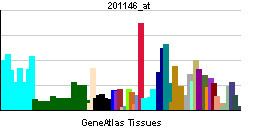Species Human Entrez 4780 | Human Mouse Ensembl ENSG00000116044 | |
 | ||
Aliases NFE2L2, NRF2, HEBP1, nuclear factor, erythroid 2 like 2 External IDs MGI: 108420 HomoloGene: 2412 GeneCards: NFE2L2 | ||
Nuclear factor (erythroid-derived 2)-like 2, also known as NFE2L2 or Nrf2, is a transcription factor that in humans is encoded by the NFE2L2 gene. Nrf2 is a basic leucine zipper (bZIP) protein that regulates the expression of antioxidant proteins that protect against oxidative damage triggered by injury and inflammation. Several drugs that stimulate the NFE2L2 pathway are being studied for treatment of diseases that are caused by oxidative stress.
Contents
Function
NFE2L2 and other genes, such as NFE2 and NFE2L1, encode basic leucine zipper (bZIP) transcription factors. They share highly conserved regions that are distinct from other bZIP families, such as JUN and FOS, although remaining regions have diverged considerably from each other.
Under normal or unstressed conditions, Nrf2 is kept in the cytoplasm by a cluster of proteins that degrade it quickly. Under oxidative stress, Nrf2 is not degraded, but instead travels to the nucleus where it binds to a DNA promoter and initiates transcription of antioxidative genes and their proteins.
Nrf2 is kept in the cytoplasm by Kelch like-ECH-associated protein 1 (KEAP1) and Cullin 3 which degrade Nrf2 by ubiquitination. Cullin 3 ubiquitinates Nrf2, while Keap1 is a substrate adaptor protein that facilitates the reaction. Once Nrf2 is ubiquitinated, it is transported to the proteasome, where it is degraded and its components recycled. Under normal conditions Nrf2 has a half-life of only 20 minutes. Oxidative stress or electrophilic stress disrupts critical cysteine residues in Keap1, disrupting the Keap1-Cul3 ubiquitination system. When Nrf2 is not ubiquitinated, it builds up in the cytoplasm, and translocates into the nucleus. In the nucleus, it combines (forms a heterodimer) with one of small Maf proteins (MAFF, MAFG, MAFK) and binds to the antioxidant response element (ARE) in the upstream promoter region of many antioxidative genes, and initiates their transcription.
Target genes
Activation of Nrf2 results in the induction of many cytoprotective proteins. These include, but are not limited to, the following:
Structure
Nrf2 is a basic leucine zipper (bZip) transcription factor with a Cap “n” Collar (CNC) structure.
Nrf2 possesses six highly conserved domains called Nrf2-ECH homology (Neh) domains. The Neh1 domain is a CNC-bZIP domain that allows Nrf2 to heterodimerize with small Maf proteins (MAFF, MAFG, MAFK). The Neh2 domain allows for binding of Nrf2 to its cytosolic repressor Keap1. The Neh3 domain may play a role in Nrf2 protein stability and may act as a transactivation domain, interacting with component of the transcriptional apparatus. The Neh4 and Neh5 domains also act as transactivation domains, but bind to a different protein called cAMP Response Element Binding Protein (CREB), which possesses intrinsic histone acetyltransferase activity. The Neh6 domain may contain a degron that is involved in the degradation of Nrf2, even in stressed cells, where the half-life of Nrf2 protein is longer than in unstressed conditions.
Tissue distribution
Nrf2 is ubiquitously expressed with the highest concentrations (in descending order) in the kidney, muscle, lung, heart, liver, and brain.
Clinical drug target
Tecfidera (dimethyl fumarate or BG-12), marketed by Biogen Idec, was approved by the Food and Drug Administration (FDA) on March 27, 2013 following the conclusion of Phase 3 clinical trials which demonstrated that the drug reduced relapse rates and increased time to progression of disability in patients with multiple sclerosis. The mechanism by which Tecfidera exerts its therapeutic effect is unknown. Tecfidera (and its metabolite, monomethyl fumarate) activates the Nrf2 pathway and has been identified as a nicotinic acid receptor agonist in vitro. Adverse events associated with Tecfidera include flushing and gastrointestinal events, such as diarrhea, nausea, and upper abdominal pain, as well as decreased lymphocyte counts and elevated liver aminotransferase levels.
The dithiolethiones are a class of organosulfur compounds, of which oltipraz, an NRF2 inducer, is the best studied. Oltipraz inhibits cancer formation in rodent organs, including the bladder, blood, colon, kidney, liver, lung, pancreas, stomach, and trachea, skin, and mammary tissue. However, clinical trials of oltipraz have not demonstrated efficacy and have shown significant side effects, including neurotoxicity and gastrointestinal toxicity. Oltipraz also generates superoxide radical, which can be toxic.
Bardoxolone methyl, a synthetic oleanane triterpenoid compound, is under clinical investigation for the treatment of pulmonary hypertension.
RTA 408 is a synthetic triterpenoid. Preclinical studies have demonstrated that it possesses antioxidative and anti-inflammatory activities, as well as the potential to improve mitochondrial bioenergetics. A Phase 2 clinical studies is evaluating RTA 408 for the prevention of radiation-induced dermatitis.
Potential adverse effects of NRF2 activation
Genetic activation of NRF2 may promote the development of de novo cancerous tumors as well as the development of atherosclerosis by raising plasma cholesterol levels and cholesterol content in the liver. It has been suggested that the latter effect may overshadow the potential benefits of antioxidant induction afforded by NRF2 activation.
Interactions
NFE2L2 has been shown to interact with:
